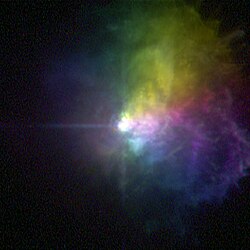Õż¦ńŖ¼Õ║¦VY ’╝łVY Canis Majoris ’╝īVY CMa’╝ēµś»õĖĆķĪåõĮŹµ¢╝Õż¦ńŖ¼Õ║¦ ńÜäń┤ģĶČģÕĘ©µś¤ µł¢ń┤ģńē╣ĶČģÕĘ©µś¤’╝īĶĘØķøóÕ£░ńÉā3900ÕģēÕ╣┤ ’╝īĶ”¢µś¤ńŁē 7.95ŃĆéµōܵĩµĖ¼’╝īÕģČĶ│¬ķćÅń┤äńé║30’Į×40ÕĆŹÕż¬ķÖĮĶ│¬ķćÅ ’╝īÕŹŖÕŠæń┤äµ£ē1,420ÕĆŹÕż¬ķÖĮÕŹŖÕŠæŃĆéÕż¦ńŖ¼Õ║¦VYõĖŹÕāģÕĘ©Õż¦’╝īÕģēÕ║” õ╣¤µ£ēÕż¬ķÖĮńÜä50ĶɼÕĆŹõ╣ŗÕżÜ’╝īµś»ÕģēÕ║”µ£Ćķ½śńÜäµüåµś¤õ╣ŗõĖĆ ’╝īÕøĀµŁżõ╣¤Ķó½µŁĖńé║ńē╣ĶČģÕĘ©µś¤ ŃĆéÕ«āÕÆīÕģČõ╗¢Õż¦ķā©ÕłåÕć║ńÅŠÕ£©Ķü»µś¤ µł¢ÕżÜķ揵ś¤ ń│╗ńĄ▒õĖŁńÜäńē╣ĶČģÕĘ©µś¤õĖŹÕÉīńÜ䵜»’╝īÕ«āµś»Õ¢«õĖƵüåµś¤ŃĆéÕż¦ńŖ¼Õ║¦VYÕÉīµÖéõ╣¤µś»Ķ«ŖÕģēķĆ▒µ£¤ń┤ä2000µŚźńÜäÕŹŖĶ”ÅÕēćĶ«Ŗµś¤ŃĆéÕ╣│ÕØćÕ»åÕ║”µś»5Õł░10mg/m3 ŃĆé
Õ”éµ×£Õ░ćÕż¦ńŖ¼Õ║¦VYµöŠÕ£©Õż¬ķÖĮń│╗ õĖŁÕ┐ā’╝īÕ«āńÜäĶĪ©ķØóõĮŹńĮ«Õ░ćµ£āÕ£©Õ£¤µś¤ Ķ╗īķüōõ╣ŗÕż¢’╝øõĖŹķüÄõ╣¤µ£ēÕż®µ¢ćÕŁĖÕ«ČĶ¬Źńé║Ķ®▓µüåµś¤ÕŹŖÕŠæµćēµś»Õ░ÅÕŠŚÕżÜ’╝īÕż¦ń┤ä600ÕĆŹńÜäÕż¬ķÖĮÕŹŖÕŠæ’╝īÕ£©ńü½µś¤Ķ╗īķüōõ╣ŗÕż¢[ 12]
Õż¦ńŖ¼Õ║¦VYķ”¢µ¼ĪĶ¦ĆµĖ¼ń┤Ćķī䵜»1801Õ╣┤3µ£ł7µŚźµ│ĢÕ£ŗÕż®µ¢ćÕŁĖÕ«Čńå▒ńŠģÕ¦å┬ʵŗēµ£ŚÕŠĘ Õ░ćÕ«āõ╗źõĖĆķĪåĶ”¢µś¤ńŁē7ńŁēµüåµś¤Ķ©śķīäÕ£©õ╗¢ńÜ䵜¤ĶĪ©õĖŁŃĆéõ╣ŗÕŠīÕ£©19õĖ¢ń┤ĆńĀöń®ČÕģČÕģēÕ║”µÖéĶ¬Źńé║õ╗¢ńÜ䵜¤ńŁēÕ£©1850Õ╣┤ķ¢ŗÕ¦ŗõĖŗķÖŹ[ 13]
Ķć¬1847Õ╣┤ķ¢ŗÕ¦ŗÕĘ▓ń¤źÕż¦ńŖ¼Õ║¦VYµś»õĖĆķĪåµĘ▒ń┤ģĶē▓µüåµś¤[ 13] ÕżÜķ揵ś¤ ŃĆéõ╗ŖµŚźµłæÕĆæń¤źķüōķĆÖõ║øµśÄõ║«ÕŹĆÕ¤¤ÕģČÕ»”µś»Õż¦ńŖ¼Õ║¦VYÕæ©Õ£Źķø▓µ░ŻńÜ䵜Äõ║«ķā©ÕłåŃĆé1957Õ╣┤ńÜäÕģēÕŁĖĶ¦ĆµĖ¼ÕÆī1998Õ╣┤ńÜäķ½śĶ¦Żµ×ÉÕ║” Ķ¦ĆµĖ¼ķāĮńó║Ķ¬ŹÕż¦ńŖ¼Õ║¦VYµ▓Ƶ£ēõ╝┤µś¤[ 7] [ 13]
Õż¦ńŖ¼Õ║¦VYµś»õĖĆķĪåķ½śÕģēÕ║”ńÜäMÕ×ŗ µüåµś¤’╝īĶĪ©ķØóµ£ēµĢłµ║½Õ║”ń┤ä3000K’╝īÕ£©ĶĄ½ńŠģÕ£¢ õĮŹµ¢╝ÕÅ│õĖŖĶ¦Æ’╝īÕøĀµŁżÕ«āµłÉńé║ĶČģÕĘ©µś¤ńÜäķüÄń©ŗĶó½Ķ¬Źńé║µś»ńøĖńĢČĶżćķø£ŃĆéĶĆīÕ«āÕÅ»ĶāĮÕĤµ£¼µś»OÕ×ŗõĖ╗Õ║ŵś¤ [ 11] M Ōśē [ 7]
µüåµś¤ĶĘØķøóÕÅ»õ╗źõĮ┐ńö©Õ£░ńÉāń╣×Õż¬ķÖĮÕģ¼ĶĮēµÖéńöóńö¤ńÜäĶ”¢ÕĘ« ķćŵĖ¼ŃĆéõĮåµś»Õż¦ńŖ¼Õ║¦VYńÜäĶ”¢ÕĘ«ķüÄÕ░Å’╝īõĖöĶ¬żÕĘ«ķüÄÕż¦ĶĆīńäĪµ│ĢõĮ┐ńö©µŁżµ│Ģ[ 14]
1976Õ╣┤µ¤źńłŠµ¢»┬ʵŗēķüö’╝łCharles J. Lada’╝ēÕÆīķ”¼Õģŗ┬ĘķćīÕŠĘ’╝łMark J. Reid’╝ēÕ£©Õż¦ńŖ¼Õ║¦VYµØ▒µ¢╣15Ķ¦ÆÕłå ĶÖĢńÖ╝ńÅŠõĖĆÕĆŗÕłåÕŁÉķø▓ ŃĆéĶ®▓ÕłåÕŁÉķø▓ńÜäķéŖńĘŻµ£ēõĖĆÕĆŗµśÄõ║«ńÜäńÆ░’╝īÕ£©ńÆ░ĶÖĢµ£ēµśÄķĪ»ńÜäõĖƵ░¦Õī¢ńó│ ĶŁ£ńĘÜÕ╝ĘÕ║”Õż¦Õ╣ģõĖŗķÖŹ’╝īõĖö 12 COń¢ÅµĢŻµś¤Õ£ś NGC 2362 ÕÆīÕ£░ńÉāńÜäĶĘØķøóńøĖÕÉī’╝īÕøĀµŁżµś¤Õ£śõĖŁńÜäµüåµś¤Õ░ćńÆ░õĖŁńÜäÕłåÕŁÉķø╗ķøóõ║åŃĆéNGC 2362ÕÆīÕ£░ńÉāńÜäĶĘØķøóõ╗źķĪÅĶē▓’╝Źµś¤ńŁēÕ£¢ ÕłżÕ«Üµś»1500 ┬▒ 500ń¦ÆÕĘ«ĶĘØ [ 11]
Õż¦ńŖ¼Õ║¦VYõĮŹµ¢╝ńÆ░ńÜäõĖĆĶ¦Æ’╝īÕøĀµŁżÕ«āÕÅ»ĶāĮÕÆīÕłåÕŁÉķø▓µ£ēķŚ£Ķü»ŃĆ鵣żÕż¢’╝īÕłåÕŁÉķø▓ńÜäķƤÕ║”ķØ×ÕĖĖµÄźĶ┐æÕż¦ńŖ¼Õ║¦VYńÜäÕŠæÕÉæķƤÕ║” ŃĆéķĆÖĶ┐æõĖƵŁźķĪ»ńż║Õż¦ńŖ¼Õ║¦VYÕÆīÕłåÕŁÉķø▓õ╗źÕÅŖµś¤Õ£śNGC 2362ńøĖķŚ£’╝īķĆÖµäÅÕæ│ĶæŚÕż¦ńŖ¼Õ║¦VYńÜäĶĘØķøóõ╣¤µś»1500ń¦ÆÕĘ«ĶĘØ[ 15]
Õż¦Õ×ŗńäĪńĘÜķø╗µ£øķüĀķÅĪķÖŻÕłŚõĮ┐ńö©VLBI µĖ¼ķćŵ¢╣µ│Ģ’╝īÕÅ»õ╗źµø┤ń▓Šńó║ńÜäµĖ¼ķćÅĶ”¢ÕĘ«ŃĆéõĮ┐ńö© VLBI µÉŁķģŹµ░┤ķéüÕ░ä ÕÅ»õ╗źĶ¦ĆµĖ¼Õł░Õż¦ńŖ¼Õ║¦VYĶĘØķøóµłæÕĆæ7000113999999999999ŌÖĀ 1.14+0.11 [ 16] ķéüÕ░ä ķćÅÕł░ńÜäĶĘØķøóÕē浜»7000120000000000000ŌÖĀ 1.20+0.13 [ 6] Ķōŗõ║×õ╗╗ÕŗÖ ÕÅ»õ╗źĶ«ōµłæÕĆæńŹ▓ÕŠŚµø┤ń▓Šńó║ńÜäĶ│ćµ¢ÖŃĆé
ÕŠ×ÕĘ”Õł░ÕÅ│ÕłåÕłźµś»ńøĖńĢȵ¢╝õĖĆÕĆŗńĢ½ń┤ĀÕż¦Õ░ÅńÜäÕż¬ķś│ ŃĆüµēŗµ¦Źµś¤ ŃĆüķ╗āńē╣ĶČģÕĘ©µś¤õ╗ÖÕÉÄÕ║¦Žü ŃĆüÕÅéÕ«┐Õøø ÕÆīÕż¦ńŖ¼Õ║¦VY Õż¬ķÖĮń│╗ ĶĪīµś¤ ĶłćÕģČõ╗¢ń¤źÕÉŹµüåµś¤ńÜäµ»öĶ╝ā’╝īÕīģÕÉ½Õż¦ńŖ¼Õ║¦VYµ░┤µś¤ < ńü½µś¤ < ķćæµś¤ < Õ£░ńÉā Õ£░ńÉā < µĄĘńÄŗµś¤ < Õż®ńÄŗµś¤ < Õ£¤µś¤ < µ£©µś¤ µ£©µś¤ < µ▓āÕż½359 < Õż¬ķÖĮ < Õż®ńŗ╝µś¤ Õż®ńŗ╝µś¤ < ÕīŚµ▓│õĖē < Õż¦Ķ¦Æµś¤ < ńĢóÕ«┐õ║ö ńĢóÕ«┐õ║ö < ÕÅāÕ«┐õĖā < Õ┐āÕ«┐õ║ī < ÕÅāÕ«┐Õøø ÕÅāÕ«┐Õøø < ķĆĀńłČÕøø < õ╗ÖńÄŗÕ║¦VV <Õż¦ńŖ¼Õ║¦VY Õż¦ńŖ¼Õ║¦VY < ńøŠńēīÕ║¦UY
ÕéÖĶ©╗’╝ÜõĖŖĶ┐░ń¼¼7ķ╗×ńÜäÕż¦ńŖ¼Õ║¦VYÕÅŖÕż¦Õ░ŵ»öĶ╝āĶ¬¬µśÄ: ń¦æÕŁĖÕ«ČńÅŠõ╗ŖÕĘ▓ńČōńÖ╝ńÅŠõĖĆķĪåµ»öÕż¦ńŖ¼Õ║¦VYµø┤Õż¦ńÜäµüåµś¤’╝īÕ«āÕ░▒µś»ńøŠńēīÕ║¦UY’╝īķĆÖķĪåµüåµś¤µś»õĮŹµ¢╝ńøŠńēīÕ║¦ĶŻĪńÜäń┤ģĶē▓ĶČģÕĘ©µś¤’╝īµś»Ķć│õ╗Ŗõ║║ķĪ×ÕĘ▓ń¤źķ½öń®Źµ£ĆÕż¦ńÜäµüåµś¤’╝īõĮåńø«ÕēŹķĆÖÕĆŗķĀŁķŖ£ÕĘ▓Ķó½ÕÅ▓ĶÆéµ¢ćµŻ«2-18ÕÅ¢õ╗ŻŃĆé
[ 9] 7015700000000000000ŌÖĀ 7├Ś 1015 [ 17] 7037105000000000000ŌÖĀ 1.05├Ś 1037
Õ”éµ×£Õ£░ńÉāµś»õĖĆÕĆŗńø┤ÕŠæ1Õģ¼ÕłåńÉāķ½ö’╝īÕż¬ķÖĮµś»ĶĘØķøó117Õģ¼Õ░║õ╣ŗÕż¢ńø┤ÕŠæ109Õģ¼ÕłåńÜäńÉāķ½ö’╝īńģ¦õ╗źõĖŖµ»öõŠŗµÅøń«ŚÕż¦ńŖ¼Õ║¦VYķĀɵĖ¼µ£ĆÕż¦ńø┤ÕŠæÕż¦ń┤䵜»2.3Õģ¼ķćīŃĆéµĀ╣µōܵ£ĆĶ┐æńöÜÕż¦µ£øķüĀķÅĪ ńÜäĶ¦ĆµĖ¼ńĄÉµ×£ķĪ»ńż║ÕģČńø┤ÕŠæÕż¦ń┤䵜»1,420┬▒ 120ÕĆŹÕż¬ķÖĮÕŹŖÕŠæ[ 18]
2006Õ╣┤Ķś┐ÕŗāÕĪö┬Ęķ¤ōń”Åńæ×õ╗źÕż¦ńŖ¼Õ║¦VYńÜäÕģēĶŁ£ĶāĮķćÅÕłåÕĖā ĶĘØķøóĶ©łń«ŚÕ«āńÜäÕģēÕ║”ŃĆéÕøĀńé║Õż¦ÕżÜµĢĖĶ╝╗Õ░äķāĮĶó½µüåµś¤Õæ©Õ£Źķø▓µ░ŻõĖŁńÜäÕĪĄÕ¤āķś╗µōŗ’╝īķ¤ōń”Åńæ×ńÜäń®ŹÕłåĶ©łń«ŚõĖŁµŖŖķĆÜķüĵĢ┤ÕĆŗķø▓µ░ŻńÜäńĖĮĶ╝╗Õ░äĶ©łń«ŚķĆ▓ÕÄ╗’╝īńĄÉµ×£µś»Õ«āńÜäÕģēÕ║”ńé║7005430000000000000ŌÖĀ 4.3├Ś 105 L Ōśē [ 9] [ 19]
Õż¦ńŖ¼Õ║¦VYńłåńÖ╝µÖéÕÖ┤Õć║Õż¦ķćŵ░Żķ½ö[ 20] Õż®µ¢ćÕŁ”ńĢīÕ»╣Õż¦ńŖ¼Õ║¦VYńÜäÕż¦Õ░ŵ£ēÕŠłÕż¦ńÜäõ║ēĶ««’╝īõĖĆń¦ŹĶ¦éńé╣Ķ«żõĖ║’╝īĶ┐Öķ󌵜¤µś»õĖĆõĖ¬ÕĘ©Õż¦µśÄõ║«ńÜäń║óĶē▓ńē╣ĶČģÕĘ©µś¤[ 9] [ 12]
ķÖżõ║åķ½öń®Źõ╗źÕż¢’╝īÕż¦ńŖ¼Õ║¦VYńÜäÕģēÕ║”õ╣¤µś»ńłŁĶŁ░Ķ½¢ķ╗×ŃĆéķ¤ōń”Åńæ×Ķ¬Źńé║ÕÅ»Ķ”ŗÕģēµĖ¼Õģē µś»õĖŹÕżĀńÜä’╝īÕøĀńé║µüåµś¤Õæ©Õ£ŹńÜäÕĪĄÕ¤āµ£āõĮ┐ÕÅ»Ķ”ŗÕģēµ│óķĢĘĶ«ŖķĢĘĶĆīĶ«ŖµłÉń┤ģÕż¢ńĘÜ[ 9]
Õż¦ńŖ¼Õ║¦VYõ╣¤Õć║ńÅŠõ║åÕ”éõĮĢńĢīÕ«ÜķĆÖķĪ×ÕĘ©Õż¦µüåµś¤ŃĆīĶĪ©ķØóŃĆŹ’╝łõ╗źÕÅŖÕŹŖÕŠæ’╝ēńÜäÕĢÅķĪīŃĆéÕ«āńÜäÕ╣│ÕØćÕ»åÕ║”µś»0.000005Õł░0.000010 kg/m3 ’╝īÕ░æµ¢╝Õ£░ńÉāµĄĘÕ╣│ķØóÕż¦µ░ŻÕ»åÕ║”ÕŹāÕłåõ╣ŗõĖĆŃĆéÕøĀńé║µüåµś¤Õ»åÕ║”µ£āķÜ©µĘ▒Õ║”Ķ«ŖÕī¢’╝łķĆ▓ĶĪīµĀĖĶ׏ÕÉłńÜäµĀĖÕ┐āÕ»åÕ║”Õ┐ģķĀłµźĄķ½ś’╝ē’╝īÕøĀµŁżµüåµś¤ĶĪ©ķØóńÜäÕ»åÕ║”µ»öńČōńö▒µüåµś¤Ķ│¬ķćÅÕÆīķ½öń®ŹĶ©łń«ŚÕć║ńÜäÕ»åÕ║”’╝łĶ│¬ķćÅķÖżõ╗źķ½öń®Ź’╝īńÉāķ½öķ½öń®Źµś» 4/3 * pi * r3 ’╝īpi µś»Õ£ōÕæ©ńÄć’╝īr µś»ÕŹŖÕŠæ’╝ēńöÜĶć│µś»Õ£░ńÉāķ½śÕ▒żÕż¦µ░ŻńÜäÕ»åÕ║”Ķ”üõĮÄŃĆéķĆÖõ╗ŻĶĪ©õ║åÕ£©µŖĆĶĪōõĖŖńó║իܵüåµś¤ÕŹŖÕŠæńÜäÕģ®ķøŻńŗƵ│üŃĆéõŠŗÕ”éÕāÅĶ¤╣ńŗƵś¤ķø▓ ķĆÖµ©ŻńÜäĶČģµ¢░µś¤ķüŚĶ┐╣ Õ░▒µ£ēõĖĆÕĆŗµźĄķ½śÕ»åÕ║”ńÜäŃĆīµĀĖÕ┐āŃĆŹ’╝łõĖŁÕŁÉµś¤ ’╝ēÕÆīÕæ©Õ£ŹÕ╗Żķüö11ÕģēÕ╣┤ńÜäŃĆīÕż¦µ░ŻÕ▒żŃĆŹ’╝øĶĆīÕż¬ķÖĮńÜäÕŹŖÕŠæńĢīÕ«ÜՊ׵£¬Õ░浌źÕåĢ Ķ©łń«ŚķĆ▓ÕÄ╗ŃĆéķĆÖĶŻĪµø┤Õż¦ńÜäÕĢÅķĪīµś»Õż¬ķÖĮńÜ䵌źÕåĢµ║½Õ║”ÕÆīÕ»åÕ║”ķāĮµ»öÕż¦ńŖ¼Õ║¦VYńÜäŃĆīĶĪ©ķØóŃĆŹõŠåÕŠŚķ½śŃĆéĶĆīĶć│õ╗ŖÕ░ܵ£¬Õ╗║ń½ŗõĖĆÕĆŗµüåµś¤ÕÖ┤ńÖ╝Õ▒żµś»ÕÉ”Õ▒¼µ¢╝µüåµś¤ÕŹŖÕŠæń»äÕ£ŹńÜäÕłåńĢīńĘÜŃĆé
Õż¦ńŖ¼Õ║¦VYńø«ÕēŹńÜäńŗƵģŗķØ×ÕĖĖõĖŹń®®Õ«Ü’╝īõĖ”õĖöÕ░ćńøĖńĢČÕż¦ķćÅńÜäńē®Ķ│¬ÕÖ┤ńÖ╝ķĆ▓ÕģźÕæ©Õ£ŹńÜäķø▓µ░ŻŃĆéÕż®µ¢ćÕŁĖÕ«Čõ╗źÕōłõ╝»Õż¬ń®║µ£øķüĀķÅĪ Ķ¦ĆµĖ¼ÕŠīķĀɵĖ¼Õ«āÕ░ćµ£āÕ£©õ╣ŗÕŠī10ĶɼÕ╣┤Õģ¦õ╗źµźĄĶČģµ¢░µś¤ ńĄÉµØ¤ńö¤ÕæĮ[ 21]
ńÉåĶ½¢õĖŖµźĄĶČģµ¢░µś¤µ£āńöóńö¤õ╝ĮńÄøÕ░äń║┐µÜ┤ ’╝īµ£āõĮ┐µś¤ń│╗õĖŁķā©ÕłåÕŹĆÕ¤¤ÕÅŚÕł░ńĀ┤ÕŻ×’╝īõĖ”µ»Ćµ╗ģķÖäĶ┐æµĢĖÕģēÕ╣┤Õģ¦ńÜäńö¤ÕæĮ’╝øõĖŹķüÄńø«ÕēŹÕ£░ńÉāķÖäĶ┐æõĖ”µ▓Ƶ£ēĶĘØķøóĶ┐æÕł░ĶČ│õ╗źķĆĀµłÉÕ©üĶäģńÜäńē╣ĶČģÕĘ©µś¤ŃĆé
^ 1.0 1.1 1.2 1.3 1.4 1.5 1.6 SIMBAD basic query result: VY Canis Majoris . SIMBAD, Centre de Donn├®es astronomiques de Strasbourg. [March 7, 2009] . ’╝łÕĤզŗÕåģÕ«╣ÕŁśµĪŻ õ║Ä2016-07-16’╝ē. ^ GCVS Query=VY CMa . General Catalogue of Variable Stars @ Sternberg Astronomical Institute, Moscow, Russia . [2010-11-24 ] . ’╝łÕĤզŗÕåģÕ«╣ ÕŁśµĪŻõ║Ä2019-02-21’╝ē. ^ 3.0 3.1 Hipparchos catalogue: query form . CASU Astronomical Data Centre. Cambridge Astronomical Survey Unit. 2006 [March 10, 2009] . ’╝łÕĤզŗÕåģÕ«╣ ÕŁśµĪŻõ║Ä2016Õ╣┤3µ£ł3µŚź’╝ē. ^ 4.0 4.1 Lipscy, S. J.; Jura, M.; Reid, M. J. Radio photosphere and mass-loss envelope of VY Canis Majoris . The Astrophysical Journal (The American Astronomical Society). June 10, 2005, 626 (1): 439ŌĆō445. Bibcode:2005ApJ...626..439L arXiv:astro-ph/0502586 doi:10.1086/429900 ^ Monnier, J. D.; Geballe, T. R.; Danchi, W. C. Temporal variations of midinfrared spectra in late-type stars . The Astrophysical Journal (American Astronomical Society). August 1, 1998, 502 (2): 833ŌĆō846. Bibcode:1998ApJ...502..833M arXiv:astro-ph/9803027 doi:10.1086/305945 ^ 6.0 6.1 Zhang, B.; Reid, M. J.; Menten, K. M.; Zheng, X. W. Distance and Kinematics of the Red Hypergiant VY CMa: VLBA and VLA Astrometry. The Astrophysical Journal . January 2012, 744 (1): 23 [14 Sep 2011 (v1)]. Bibcode:2012ApJ...744...23Z arXiv:1109.3036 doi:10.1088/0004-637X/744/1/23 ^ 7.0 7.1 7.2 Wittkowski, M.; Langer, N.; Weigelt, G. Diffraction-limited speckle-masking interferometry of the red supergiant VY CMa. Astronomy and Astrophysics (European Southern Observatory). October 27, 1998, 340 : 39ŌĆō42. ^ Monnier, J. D.; Danchi, W. C.; Hale, D. S.; Lipman, E. A.; Tuthill, P. G.; Townes, C. H. Mid-infrared interferometry on spectral lines. II. Continuum (dust) emission around IRC +10216 and VY Canis Majoris . The Astrophysical Journal (The American Astronomical Society). November 10, 2000, 543 (2): 861ŌĆō867. Bibcode:2000ApJ...543..861M arXiv:astro-ph/0007393 doi:10.1086/317126 ^ 9.0 9.1 9.2 9.3 9.4 Humphreys, Roberta. VY Canis Majoris: the astrophysical basis of its luminosity. arXiV. October 13, 2006. arXiv:astro-ph/0610433 ^ Monnier, J. D.; Tuthill, P. G.; Lopez, B.; Cruzalebes, P.; Danchi, W. C.; Haniff, C. A. The last gasps of VY Canis Majoris: aperture synthesis and adaptive optics imagery . The Astrophysical Journal (American Astronomical Society). February 10, 1999, 512 (1): 351ŌĆō361. Bibcode:1999ApJ...512..351M arXiv:astro-ph/9810024 doi:10.1086/306761 ^ 11.0 11.1 11.2 11.3 Lada, Charles J.; Reid, Mark J. CO observations of a molecular cloud complex associated with the bright rim near VY Canis Majoris . The Astrophysical Journal (American Astronomical Society). January 1, 1978, 219 : 95ŌĆō104. Bibcode:1978ApJ...219...95L doi:10.1086/155758 ^ 12.0 12.1 Massey, Philip; Levesque, Emily M.; Plez, Bertrand. Bringing VY Canis Majoris down to size: an improved determination of its effective temperature . The Astrophysical Journal. August 1, 2006, 646 (2): 1203ŌĆō1208. Bibcode:2006ApJ...646.1203M arXiv:astro-ph/0604253 doi:10.1086/505025 ^ 13.0 13.1 13.2 Robinson, L. J. Three somewhat overlooked facets of VY Canis Majoris. Commission 27 of the I. A. U., Information Bulletin on Variable Stars (Konkoly Observatory, Budapest). December 7, 1971, (599). ^ Pogge, Richard W. Stellar distances . Astronomy 162: Introduction to Stars, Galaxies and the Universe. Ohio State University. October 31, 2006 [March 20, 2009] . ’╝łÕĤզŗÕåģÕ«╣ÕŁśµĪŻ õ║Ä1999-09-01’╝ē. ^ Lada, C. J.; Reid, M. The discovery of a molecular cloud associated with VY CMa. Bulletin of the American Astronomical Society (American Astronomical Society). March 1976, 8 : 322. ^
Choi, Y. K.; Hirota, Tomoya; Honma, Mareki; Kobayashi, Hideyuki; Bushimata, Takeshi; Imai, Hiroshi; Iwadate, Kenzaburo; Jike, Takaaki; Kameno, Seiji; Kameya, O.; Kamohara, R.; Kan-Ya, Y.; Kawaguchi, N.; Kijima, M.; Kim, M. K.; Kuji, S.; Kurayama, T.; Manabe, S.; Maruyama, K.; Matsui, M.; Matsumoto, N.; Miyaji, T.; Nagayama, T.; Nakagawa, A.; Nakamura, K.; Oh, C. S.; Omodaka, T.; Oyama, T.; Sakai, S.; et al. Distance to VY VMa with VERA. Publications of the Astronomical Society of Japan (Publications Astronomical Society of Japan). 2008, 60 (5): 1007. Bibcode:2008PASJ...60.1007C arXiv:0808.0641 doi:10.1093/pasj/60.5.1007
^ ÕüćĶ©ŁÕż¦ńŖ¼Õ║¦VYÕŹŖÕŠæ9.58Õż®µ¢ćÕ¢«õĮŹµÖé’╝īķ½öń®Źńé║7037123000000000000ŌÖĀ 1.23├Ś 1037 m3 7021108000000000000ŌÖĀ 1.08├Ś 1021 m3 7016114000000000000ŌÖĀ 1.14├Ś 1016
^ Õ╝Ģńö©ķöÖĶ»»’╝ܵ▓Īµ£ēõĖ║ÕÉŹõĖ║Wittkowski_vltińÜäÕÅéĶĆāµ¢ćńī«µÅÉõŠøÕåģÕ«╣
^ Spectrum of massive star VY Canis Majoris . ESA Herschel. [2011-11-15 ] . ’╝łÕĤզŗÕåģÕ«╣ÕŁśµĪŻ õ║Ä2011-08-29’╝ē. ^ HubbleSite: Astronomers Map a Hypergiant Star's Massive Outbursts . [2012-03-25 ] . ’╝łÕĤզŗÕåģÕ«╣ÕŁśµĪŻ õ║Ä2016-12-21’╝ē. ^ ÕŁśµĪŻÕē»µ£¼ . [2011-06-14 ] . ’╝łÕĤզŗÕåģÕ«╣ ÕŁśµĪŻõ║Ä2001-02-26’╝ē.

















